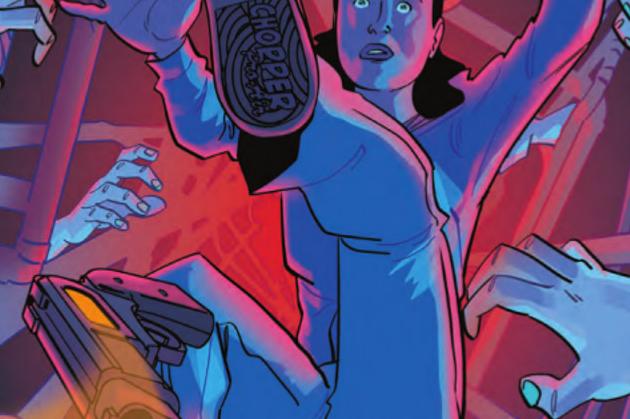BRINK, BOOK 1
Writer: Dan Abnett
Artist: INJ Culbard
Publisher: Rebellion
In a career of less than twenty years writing for pulp magazines, Howard Phillips Lovecraft created a horror pantheon that would help redefine the genre. Lovecraft’s tales of isolated communities harbouring dark secrets, of Old Gods and the insane cults who worship them, Cthulhu and R’lyeh, of madness and forbidden knowledge, still impact popular culture a century later.
Modern interpretations of Lovecraft’s mythos often feature heroic characters in the battle against evil – a spell book in one hand and a shotgun in the other, defeating crazed zealots and driving monsters back into the pit. This interpretation is at odds with the source material. In Lovecraft’s stories, humankind is insignificant. His characters are driven to insanity at the mere glimpse of the nightmarish world which exists just beyond their ken.
Brink, by Dan Abnett and INJ Culbard, is a police procedural set in a future where the Earth has been abandoned and the human race has migrated into space to live cramped and stressful lives in an array of vast space stations, known as the Brink.
Brink is Lovecraftian horror in its purest form. It examines the collective psyche of a traumatised society forced to live in unnatural conditions, gradually becoming aware of a monstrous other reality. There are no jump-scares in this horror story. Rather, Brink gradually builds a sense of existential terror as its characters come to realise that the things they know to be true cannot possibly be true.
The spacestation named Odette is owned by the Sugarsurf Pharma corporation and home to 209,000 people. Employed by the local security agency, Investigators Carl Brinkman and Bridget Kurtis stumble upon a seemingly straight forward murder which quickly spirals into an investigation encapsulating the complex politics of trade unions that have become criminal gangs and gangs that have become cults. As the pair gradually unpick this complex puzzle, they are drawn into a collective insanity based around the imminent arrival of an ancient god, and begin to loose track of reality as their actions threaten to tear the station apart.
From its first panel of a zero gravity crime scene, Brink hurls the reader into a complex and squalid world. First published within the weekly anthology 2000AD, Brink was originally printed in five page segments, resulting in a densely plotted story which constantly moves forward. The dialogue is fast moving and naturalistic and we are expected to keep up, to recall characters and their motivations mentioned briefly dozens of pages ago, to understand the complex relationship between organisations and individuals. At one point, the two lead characters gather to recap the events so far, but the reader is instead provided with several pages of entirely new world building information and a conversation on the benefits of organic food. Brink lacks any narration, only the occasional tag providing the name of a newly introduced character, a location, or an item of technology
It’s an overwhelming journey, mirroring the character’s own struggle to grasp the inconceivable forces that threaten to overwhelm them.
INJ Culbard’s distinctive art style previously helped define 2000AD’s Brass Sun, a sort of Dune/Gormenghast hybrid, as well as a comic version of the Lovecraft influencing novel The King in Yellow. Brink’s characters are visually defined in a few sparse lines and beautifully coloured. In this style, complex design of space stations and technology appear almost simplistic. The characters who inhabit this cramped world struggle with the idea of space, constantly moving in crowds and living in rooms barely large enough to lay down in, taking pills to deal with the constant pressure. So does Culbard’s art often seem to struggle with the restrictions of the page, frequently claustrophobic, with full page gutterless images and actions moving beyond the edge of the rigid panel structure.
A pair of cops trying to do the right thing and struggling with rules and bureaucracy can quickly fall into cliché, but the characters in Brink are carefully defined. We are told almost nothing about the personal lives and background of main characters Brinkman and Kurtis, but the relaxed conversational shorthand they share, and their often brusque interactions with other characters, speak volumes on their friendship and professional relationship. Their world is built not through obvious explanation for the benefit of the reader, but through small details in the writing and art.
Half way through, the story takes an unexpected turn with a sudden act of violence. Just as we begin to realise that this is a story that will continually twists and surprise us, Brink manages to supplant expectations and go further than most would dare. It's a bold move, but Brink handles it marvellously. The shock is allowed to affect the characters in an entirely real way, even amid the unreality of the situation.
Brink is original, challenging and terrifying. As is first panel cast the reader into a twisting, twisted world, so its final panel shows the human race increasingly adrift as this world falls away from under them. There is more to come, with the second book of Brink currently appearing in the pages of 2000AD, and for the humans who live on the brink, things are likely to get much worse.





